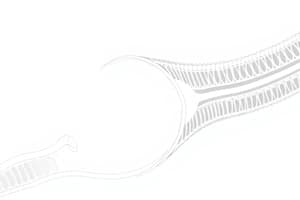Podcast
Questions and Answers
What describes the structure of the cell membrane?
What describes the structure of the cell membrane?
- A phospholipid bilayer with embedded proteins. (correct)
- A single layer of lipids with carbohydrates on the surface.
- A rigid structure composed of proteins only.
- A completely solid barrier that prevents all materials from passing.
Which mechanism requires energy for the movement of molecules?
Which mechanism requires energy for the movement of molecules?
- Active transport (correct)
- Facilitated diffusion
- Osmosis
- Diffusion
What is facilitated diffusion primarily used for?
What is facilitated diffusion primarily used for?
- The diffusion of water across the membrane.
- The passive movement of large particles without proteins.
- The movement of molecules that cannot pass freely through the membrane. (correct)
- The active transport of ions against their gradient.
What is the primary role of cholesterol in the cell membrane?
What is the primary role of cholesterol in the cell membrane?
What are lipid rafts in the cell membrane important for?
What are lipid rafts in the cell membrane important for?
Which type of endocytosis involves the uptake of large particles?
Which type of endocytosis involves the uptake of large particles?
Which factor does NOT influence membrane fluidity?
Which factor does NOT influence membrane fluidity?
What role do membrane proteins play in cell signaling?
What role do membrane proteins play in cell signaling?
Flashcards are hidden until you start studying
Study Notes
Cell Membrane Dynamics
-
Cell Membrane Structure
- Composed of a phospholipid bilayer with embedded proteins.
- Contains hydrophilic (water-attracting) heads and hydrophobic (water-repelling) tails.
- Proteins serve various functions: transport, signaling, and structural support.
-
Fluid Mosaic Model
- Describes the cell membrane as a dynamic structure with various proteins floating in or on the fluid lipid bilayer.
- Lipids and proteins can move laterally within the layer, allowing for membrane flexibility.
-
Membrane Transport Mechanisms
-
Passive Transport: Movement of molecules without energy input.
- Diffusion: Movement from high to low concentration.
- Facilitated Diffusion: Uses transport proteins for molecules that cannot pass freely through the membrane.
- Osmosis: Diffusion of water through a selectively permeable membrane.
-
Active Transport: Movement of molecules against their concentration gradient, requiring energy (ATP).
- Primary Active Transport: Direct use of ATP (e.g., Na+/K+ pump).
- Secondary Active Transport: Uses the gradient created by primary active transport (e.g., symport and antiport mechanisms).
-
-
Endocytosis and Exocytosis
-
Endocytosis: Process by which cells internalize substances.
- Phagocytosis: "Cell eating" of large particles or cells.
- Pinocytosis: "Cell drinking" of fluids and small molecules.
- Receptor-mediated endocytosis: Specific uptake of molecules via receptor binding.
-
Exocytosis: Process of vesicle fusion with the membrane to release substances outside the cell.
-
-
Membrane Potential
- The difference in electrical charge across the membrane due to ion distribution.
- Important for muscle contraction and nerve impulse transmission.
-
Cell Signaling
- Membrane proteins (receptors) bind to signaling molecules (ligands) to initiate cellular responses.
- Can involve second messengers (e.g., cAMP, calcium ions) to amplify the signal.
-
Membrane Fluidity Factors
- Temperature: Higher temperatures increase fluidity.
- Tail length and saturation: Shorter and unsaturated tails increase fluidity.
- Cholesterol: Stabilizes membrane fluidity; prevents extreme fluidity at high temperatures and rigidity at low temperatures.
-
Membrane Compartments
- Microdomains (Lipid Rafts): Distinct regions rich in cholesterol and sphingolipids that serve specific signaling functions.
-
Membrane Repair Mechanisms
- Cells possess mechanisms to repair damage to the membrane, including the recruitment of vesicles to patch holes or tears.
This overview provides a foundational understanding of cell membrane dynamics within cell biology.
Cell Membrane Structure
- Comprised of a phospholipid bilayer featuring hydrophilic heads and hydrophobic tails.
- Proteins embedded in the membrane perform functions like transport, signaling, and structural integrity.
Fluid Mosaic Model
- Describes the cell membrane as a flexible structure with various proteins dispersed throughout a lipid bilayer.
- Lipids and proteins can move laterally, contributing to the membrane's fluidity.
Membrane Transport Mechanisms
- Passive Transport: Movement of substances across the membrane without energy expenditure.
- Diffusion: Molecules move from areas of high concentration to low concentration.
- Facilitated Diffusion: Transport proteins assist the passage of molecules that cannot diffuse freely.
- Osmosis: The movement of water through a selectively permeable membrane.
- Active Transport: Energy-requiring process that moves molecules against their concentration gradient.
- Primary Active Transport: Involves direct ATP usage, exemplified by the Na+/K+ pump.
- Secondary Active Transport: Utilizes the established gradient from primary transport (includes symport and antiport).
Endocytosis and Exocytosis
- Endocytosis: Cell internalization of substances.
- Phagocytosis: Engulfing large particles or cells ("cell eating").
- Pinocytosis: Uptake of fluids and small molecules ("cell drinking").
- Receptor-Mediated Endocytosis: Selective intake of substances via specific receptors.
- Exocytosis: Process where vesicles merge with the membrane to release materials outside the cell.
Membrane Potential
- Exists due to differences in ion distribution across the membrane, creating an electrical charge.
- Crucial for muscle contractions and nerve signal transmission.
Cell Signaling
- Membrane proteins act as receptors for signaling molecules (ligands), triggering cellular responses.
- Involves second messengers (like cAMP and calcium ions) to amplify the response.
Membrane Fluidity Factors
- Temperature: Elevated temperatures enhance membrane fluidity.
- Tail Characteristics: Shorter, unsaturated lipid tails increase fluidity.
- Cholesterol: Maintains balanced fluidity, preventing excessive fluidity at high temperatures, and rigidity at low temperatures.
Membrane Compartments
- Microdomains (Lipid Rafts): Special regions enriched with cholesterol and sphingolipids that facilitate specific signaling tasks.
Membrane Repair Mechanisms
- Cells can repair membrane damage by mobilizing vesicles to patch leaks or tears, ensuring membrane integrity.
Studying That Suits You
Use AI to generate personalized quizzes and flashcards to suit your learning preferences.




